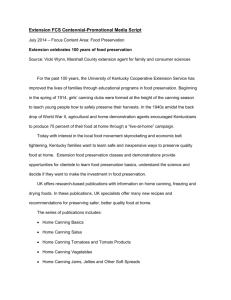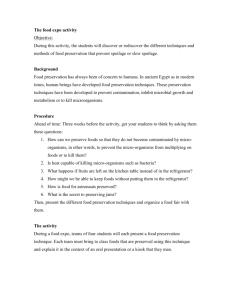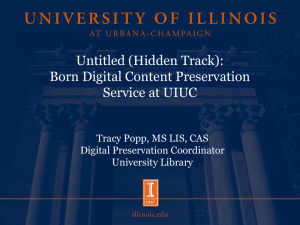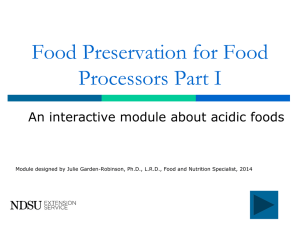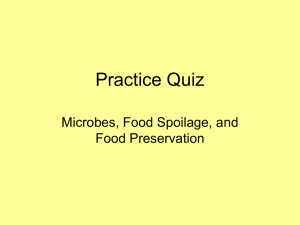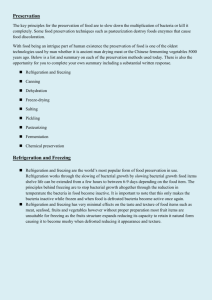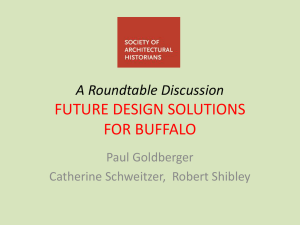food preservation - 18-202
advertisement
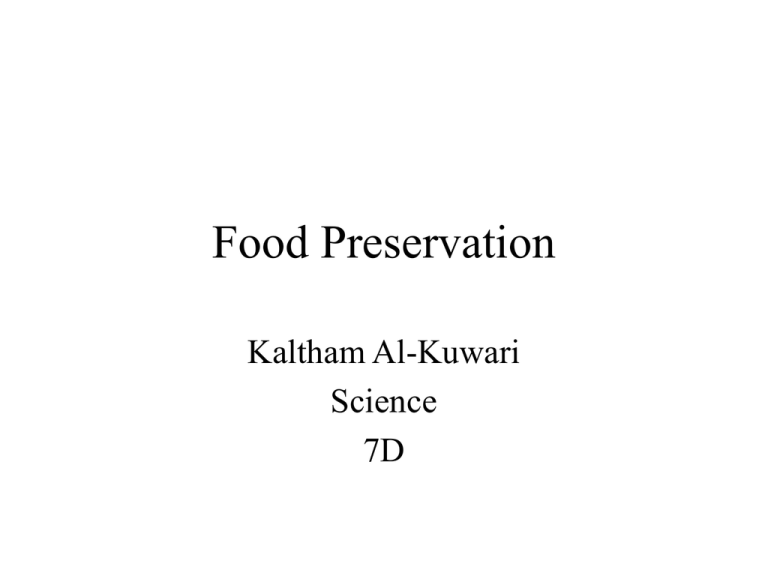
Food Preservation Kaltham Al-Kuwari Science 7D Two basic ideas behind Food Preservation The basic idea behind food preservation is usually either of these two: - To slow down the activity of disease-causing bacteria or - To kill the bacteria all together 5 different ways food can be preserved By keeping food at low temperature: Refrigeration and Freezing are probably the most popular forms in food preservation today. In refrigeration, the bacterial action on the food is slowed down; it takes a week or two to spoil. In freezing, bacterial action on the food is stopped. Bacteria are completely inactive if frozen. 1 By Drying: Dehydration is one of the 5 ways you can preserve the food. Dried fruits, potatoes in a box, dried vegetables, powdered milk, pasta, powdered soups, powdered sauces, and powdered meat you see in the grocery store are dehydrated products. When foods are dried, bacteria will become inactive. 2 3 By adding substances called preservatives: Substances that are used for preserving food are called preservatives. Sugar, salt, spices, saltpeter, and vinegar are examples of preservatives. - Salting is an old preservation technique. The food covered by salt does not spoil because bacteria cannot thrive in salty environment. Salt makes the moisture in food is also drawn out by salt. Anything that’s salted will post probably last for a year. - Pickling has been used in the past to preserve meat, fruits and vegetables. Today, it is used to make pickles. Preservative qualities of vinegar and salt are combined to produce pickles, they inhibit the growth of bacteria. 4 By Sterilization: It is a good idea to heat up the food because heat is a good way to kill bacteria and preserve the food. When that is done, it is called sterilization. Canned goods are most often preserved foods in jars that have been sterilized. 5 By excluding air: Foods kept in places where air can’t reach them are more likely to last long. It’s lasting long by excluding air. Canning is one of the famous examples of excluding air. Many foods can be canned. The Canning process has been used since 1825. The food in the can must be boiled to kill the bacteria and the can must be sealed. When the food is in the can, it doesn’t spoil because it is completely free from living germs. Preservation Effects Permitted less nomadic travels. Communities, civilizations established. Expeditions were extended in time and routes. Increasing populations had better supplies of foods. Helped eliminate food borne diseases, Supplies could last throughout seasons, extending life expectancies. Preservation Methods Five main ways to preserve foods and remove microorganisms: – Chemicals – Drying – Refrigeration – Canning – Radiation The last three methods are current practices, developed and modified in the last two centuries. Early Methods The early methods of brewing, baking, and winemaking created products that allowed trades and commerce. Storage of grains added tetracycline to the diets, which probably helped resist many diseases and infections. The preserved products also introduced proteins and vitamins into the diets. Pompeii- jars of fruit preserved in honey. Rome- first preserved ham Vikings laid fish in the riggings of their ships to let sea wind dry their fish. Early North American Indians - pemmican – Remove fat, cook meat, then grind fat and meat into a paste. – Prevented deterioration. – Important for fur traders during the 17th , 18th , 19th centuries. New stoneware developed during the 16th centuries – Could stand high temperatures 1200-1400°C Food Preservation Shift During the 17th and 18th centuries, new ingredients were being created. Imported spices and sugars increased the variety of foods. The 18th century created a shift in food preservation from a necessity for survival to a desire for delicacies. 1735- botulism first recognized (from sausage use) Food preservation methods used were not effective enough for long term use. Better methods were needed for safer food consumption. Switch from primitive methods used to flavor foods to newer scientific techniques that removed life from food. Preservation Today Freeze-drying used for military and space expeditions. – Foods subjected to high pressures – Expensive but highly effective. Radiation used frequently HTST – (High Temperature Short Time process) New food borne pathogens being discovered. Greater need for safer home and commercial preservation methods. Clostridium botulinum – most famous microorganism in food industry. Listeria monocytogenes – recent pathogen Many domestic processes: - Canning - Freezing - Blanching Or Preserving with sugars: - Jams, jellies, preserves, marmalades, butters or Oven or sun drying BIBLIOGRAPHY http://science.howstuffworks.com/innovation/edible-innovations/food-preservation.htm http://static.ddmcdn.com/gif/food-preservation-ch.jpg http://www.whatscookinglehighvalley.com/wp-content/uploads/2011/11/18_4_orig.jpg http://beth811.hubpages.com/hub/Process-Methods-in-Preserving-Foods http://salestores.com/stores/images/images_747/T12G.jpg http://schoolworkhelper.net/wp-content/uploads/2011/08/food-preservation-freezing.jpg http://www.magazine.ayurvediccure.com/wp-content/uploads/2008/12/dryfruits.gif http://sp.life123.com/bm.pix/introduction-to-the-home-canning-process-1_jars-withpreserves.s600x600.jpg THANK YOU KALTHAM AL-KUWARI


